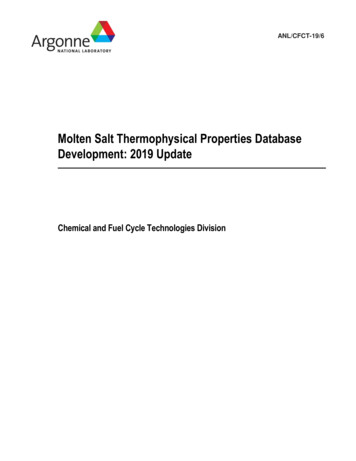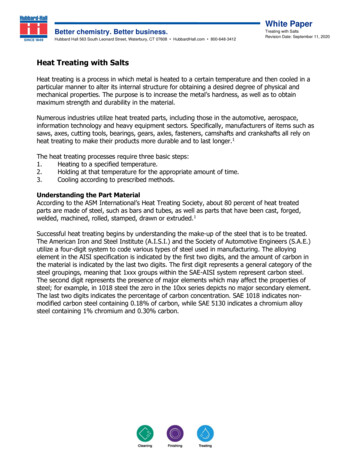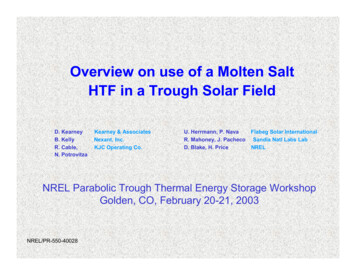
Transcription
ANL/CFCT-19/6Molten Salt Thermophysical Properties DatabaseDevelopment: 2019 UpdateChemical and Fuel Cycle Technologies Division
About Argonne National LaboratoryArgonne is a U.S. Department of Energy laboratory managed by UChicago Argonne, LLCunder contract DE-AC02-06CH11357. The Laboratory’s main facility is outside Chicago, at9700 South Cass Avenue, Argonne, Illinois 60439. For information about Argonneand its pioneering science and technology programs, see www.anl.gov.DOCUMENT AVAILABILITYOnline Access: U.S. Department of Energy (DOE) reports produced after 1991 and agrowing number of pre-1991 documents are available free at OSTI.GOV(http://www.osti.gov/), a service of the US Dept. of Energy’s Office of Scientific andTechnical Information.Reports not in digital format may be purchased by the public from theNational Technical Information Service (NTIS):U.S. Department of CommerceNational Technical Information Service5301 Shawnee RdAlexandria, VA 22312www.ntis.govPhone: (800) 553-NTIS (6847) or (703) 605-6000Fax: (703) 605-6900Email: orders@ntis.govReports not in digital format are available to DOE and DOEcontractors from the Office of Scientific and Technical Information(OSTI):U.S. Department of EnergyOffice of Scientific and Technical InformationP.O. Box 62Oak Ridge, TN 37831-0062www.osti.govPhone: (865) 576-8401Fax: (865) 576-5728Email: reports@osti.govDisclaimerThis report was prepared as an account of work sponsored by an agency of the United States Government. Neither theUnited States Government nor any agency thereof, nor UChicago Argonne, LLC, nor any of their employees or officers,makes any warranty, express or implied, or assumes any legal liability or responsibility for the accuracy, completeness,or usefulness of any information, apparatus, product, or process disclosed, or represents that its use would not infringeprivately owned rights. Reference herein to any specific commercial product, process, or service by trade name,trademark, manufacturer, or otherwise, does not necessarily constitute or imply its endorsement, recommendation, orfavoring by the United States Government or any agency thereof. The views and opinions of document authorsexpressed herein do not necessarily state or reflect those of the United States Government or any agency thereof,Argonne National Laboratory, or UChicago Argonne, LLC.
ANL/CFCT-19/6Molten Salt Thermophysical Properties DatabaseDevelopment: 2019 Updateprepared byJames JerdenChemical and Fuel Cycle Technologies Division, Argonne National Laboratoryprepared for the U.S. DOE Advanced Reactor Technology Program’s Molten Salt Reactor campaign,Salt Chemistry Work Package: AT-19AN04060104, Milestone: M4AT-19AN040601045.9/9/2019
SummaryThis report provides an update on the molten salt reactor thermophysical properties database that is beingdeveloped as part of the U.S. Department of Energy Advanced Reactor Technology Program Molten SaltReactor (MSR) campaign. A summary of recent MSR-relevant literature and a discussion of data gaps areprovided. The structure of the new MSR thermophysical properties database is outlined and three datasetsare reviewed in detail to provide examples of the data and metadata that will be included in the database.Despite the availability of some high quality MSR-relevant data-sets, there remains a need for athermophysical properties experimental program to generate data focused on addressing the design andlicensing needs of current MSR concept developers.This report represents the work product milestone M4AT-19AN040601045 for work package SaltChemistry work package AT-19AN04060104 of the Advanced Reactor Technology Program’s MSRcampaign.I
Table of ContentsSUMMARY. I1.INTRODUCTION . 32.SUMMARY OF INITIAL LITERATURE REVIEW . 42.1.3.3.1.Data needs and Prioritization . 5MSR THERMOPHYSICAL PROPERTIES DATABASE. 10MSR Thermophysical Properties Database Inputs: Example Data Sets . 113.2.Xu et al., 2018 Data Set . 113.2.1. Sample Preparation and Purity: Xu 2018 Data Set .123.2.2. Heat Capacity Measurements: Xu 2018 MgCl2-KCl Data Set .123.2.3. Viscosity Measurements: Xu 2018 MgCl2-KCl Data Set .133.2.4. Density Measurements: Xu 2018 MgCl2-KCl Data Set .143.2.5. Thermal Conductivity Measurements: Xu 2018 MgCl2-KCl Data Set .153.3.Cantor 1973, ORNL-TM-4308 Data Set . 163.3.1. Sample Preparation and Purity: Cantor 1973, ORNL-TM-4308 Data Set .163.3.2. Density Measurements: Cantor 1973, ORNL-TM-4308 Data Set.173.3.3. Viscosity Measurements: Cantor 1973, ORNL-TM-4308 Data Set.183.4.4.Cohen and Jones 1957, ORNL-2278 Data Set . 19CONCLUSIONS AND FUTURE WORK . 23REFERENCES. 24II
1. IntroductionThe U.S. Department of Energy Advanced Reactor Technology Program’s Molten Salt Reactor (MSR)campaign is developing state-of-the-art thermochemical and thermophysical properties databases to aid inthe design and licensing of new MSRs. This report provides a progress update on the development of themolten salt thermophysical properties database.The ultimate goal of the thermophysical properties database activity is to develop a state-of-the-artinformation tool that provides the fuel/coolant salt properties needed to model MSR performance as afunction of temperature, pressure and salt composition. The database will be integrated into the systemlevel modeling and simulation tools being developed as part of the MSR campaign to assess and optimizethe performance of particular MSR concepts. The specific content of the database will includeexperimentally measured thermophysical properties (e.g., density, viscosity, heat capacity and thermalconductivity) as well as predictive functions for the interpolation and extrapolation of those properties. Theenvisioned relationship between the thermophysical database and other components of the MSR modelingand simulation framework is shown Figure 1.Figure 1. Diagram showing the conceptual relationships between the thermophysical properties databaseand the thermochemical and multiphysics MSR models.To date, the thermophysical properties database development activity has involved critical reviews ofrelevant literature to provide the initial database content framework. The results of this literature reviewprovide the initial datasets for populating the database and identify specific data gaps that provide objectives3
for future R&D activities. Database development will require close coordination and discussions betweenmolten salt reactor developers, systems engineers, modeling and simulation experts, chemists and chemicalengineers to ensure the database supports project needs.2. Summary of Initial Literature ReviewThis section presents an overview of the state of knowledge regarding the essential thermophysicalproperties of MSR-relevant salt systems. The goal of this section is to provide the technical basis foridentifying and prioritizing future research and development activities that are needed to compile athermophysical properties database that can be directly integrated into reactor performance codes.There are three general applications of molten salts in these advanced nuclear reactor systems: fuel, primarycoolant, and heat exchange medium. The fuel and coolant salts consist of binary, ternary or quaternary saltmixtures that contain the fissile actinides that fission in the reactor core and are circulated within the primaryloop to the primary heat exchangers during reactor operation (e.g., Samuel, 2009). Heat from the primaryheat exchangers may then be transferred to a secondary coolant salt that does not contain fissile or fertileelements. In salt-cooled solid fueled reactors (e.g., liquid salt cooled reactors), the molten salt is restrictedto circulation within the primary cooling loop to transport heat from the core to intermediate loops that mayalso use liquid salts to transport heat to either a Brayton power cycle for electricity production or to ahydrogen production facility (Samuel, 2009, Forsberg et al., 2008).Table 1 lists examples of molten salt compositions proposed for applications in Generation IV nuclearreactor technologies.4
Table 1. Examples of applications of molten salts in proposed and tested nuclear reactor concepts (adaptedfrom Samuel, 2009).Reactor TypeNeutronSpectrumMolten SaltApplicationReference Salt 4Molten SaltBreeder Reactor2-AnF47LiF-AnF4FastFuelSelected References[Grimes, 1967][Furukawa, al. 2007][Auger, et al. 2008][Grimes, 1967][Furukawa, et al. 2007][Auger, et al. 2008][Grimes, 1967][Furukawa, al. 2007][Auger, et al. 2008]NaCl–MgCl2–UCl3–PuCl3[Beneš, Konings, 2009]LiF-NaF-BeF2-AnF3[Ignatiev, et al. 2003]][Ingersoll, et al. 2004][Williams, et al.2006]AdvancedHighTemperature ature ReactorThermalHeat transfercoolantLiF-NaF-KF[Williams, 2006]PrimarycoolantLiCl-NaCl-MgCl2[Forsberg et al. 2008]IntermediatecoolantNaNO3-KNO3[Latgé, 2008]Liquid Salt CooledFast ReactorFast2The specific salt systems and compositions that are best suited for particular applications will be based ontheir thermophysical and chemical properties. Several thermodynamic and physical properties databasesfor molten salts have been assembled and several review papers and reports summarize the substantialamount of literature in this field (e.g., Williams, 2006, Williams et al., 2006, Beneš, and Konings, 2009,Samuel, 2009, Serrano-López et al., 2013). However, there remains a need for a functional database andcomputational tool that can be used to select, optimize and predict the properties of specific molten saltmixtures being considered for current nuclear reactor applications.In general, the MSR Campaign will focus on binary, ternary and quaternary salt mixtures because themelting points of individual salts are too high for coolant/fuel applications. A number of appropriatechloride and fluoride salt systems with eutectic behavior have been identified for use as coolants and fuelin different types of nuclear reactors (see Table 1 and references cited therein). However, there remains aneed for a functional database that can support salt mixture properties modeling over the full range ofrelevant P-T-X (pressure, temperature, composition) conditions to optimize and assess the performance ofMSR designs.2.1.Data needs and PrioritizationA coolant or fuel-coolant salt must efficiently extract heat from the core at relatively high temperatures andefficiently transfer that heat to heat exchangers and energy conversion systems (e.g., steam generator5
turbine system) without introducing unmanageable safety or waste issues. Examples of some of the keyrequirements include: Neutron attenuation: the salt should not significantly attenuate neutrons.Activation: the salt should not produce significant quantities of radioactive activation productsthat could complicate regular operation tasks (low neutron absorption cross sections) orsubstantially increase the source term.Corrosion: the salt should not be aggressively corrosive to the materials of construction used forcore or loop components.Actinide solubility: the solubility of uranium, thorium and plutonium in a candidate fuel-coolantsalt should be understood and predictable over relevant temperature ranges.Salt freezing: the salt must have a melting point that is at least 50 oC lower than the lowesttemperature that will occur within the coolant loop circuit during operation.Salt decomposition or boiling: the salt must be thermally stable at temperatures well above thoseanticipated during normal and off-normal operation (i.e., under credible accident conditions).Pumpability: the salt should have a reasonably low viscosity at operating temperatures to allowpredictable flow dynamics.Vaporization: the salt should have a relatively low vapor pressure to avoid pressurization, aerosolgeneration and coolant loss issues at operating temperatures.Cost and materials availability: salt mixture components should be relatively inexpensive andreadily available to accommodate scale up and commercialization.Opacity: the salt should ideally have low opacity to allow for with optical in-service inspection ofcore and coolant loop components.Toxicity: the coolant chemistry should not pose unnecessary toxicity hazard during handling forroutine repair operations.In addition to these general considerations, Sohal et al., 2013 identify the following specific qualities asessential criteria for assessing the applicability of molten salt systems for nuclear applications. Chemical stability of salt mixture at elevated temperatures (500–800 C).Radiolytic stability of salt mixture in high radiation fields (specific to primary coolant).Low freezing temperature, preferably lower than 500 C.Large heat capacity and thermal conductivity.Low vapor pressures: less than one atmosphere at operating temperatures.Compatible with reactor core/heat exchanger materials: alloys, graphite, and ceramics.Fuel-containing salts have additional performance criteria because, in addition to carrying the fissile andfertile material, the salt may be required to act as a neutron moderator, provide negative thermal reactivityfeedback, act as the primary heat transfer medium and provide decay heat removal by natural circulation(Holcomb et al., 2011). Therefore, in addition to the requirements listed above, fuel salts also have thefollowing requirements: Very low concentrations of isotopes with high-parasitic neutron absorption cross sections withinthe relevant spectral region for a given reactor.Large coefficient of thermal expansion to provide strong negative reactivity feedback andefficient natural circulation.Ability to maintain high dissolved concentrations of fissile and fertile materials (U, Pu, Th) tosupport criticality and efficient breeding, if needed.6
The development of screening factors or operational criteria for salt systems will depend on the specificapplication within the reactor system. For example, previous studies have suggested that chloride salts areproblematic for fast reactor applications due to their relatively high thermal-neutron absorption crosssections and undesirable neutron activation properties (e.g., 36Cl) (Williams, 2006, Williams et al., 2006,Samuel, 2009). However, recent work indicates that chloride salt systems such as NaCl-MgCl2 containingfertile 238UCl3 and fissile 239PuCl3 show considerable promise as a fuel-coolant salt for fast breeder moltensalt reactors (e.g., Mourogov and Bokov, 2006, Beneš, Konings, 2009).A wealth of knowledge on the thermophysical properties of molten salts was gained at Oak Ridge NationalLaboratory in the 1950s – 1970s during the Aircraft Reactor Experiment (ARE), Molten Salt ReactorExperiment (MSRE) and the Molten Salt Breeder Reactor (MSBR) projects (Williams, 2006, Williams etal., 2006, Samuel, 2009). More recently, work in the Advanced High-Temperature Reactor (AHTR), NextGeneration Nuclear Plant (NGNP) and Nuclear Hydrogen Initiative (NHI) programs has provided importantinformation about molten salt property criteria for nuclear applications (for example, Ingersoll 2004,Williams, 2006, Williams et al., 2006). Other key information relevant to molten salt applications ascoolants and fuels in MSRs has been compiled in the European Molten Salt Technology (MOST) database(Renault and Delpech, M., 2005) and work in Russia described by Ignatiev et al., 2002, Ignatiev et al., 2003,Khokhlov et al., 2009. Furthermore, general salt properties information was made available online throughthe Molten Salt Database (MSDB) project (http://allen.neep.wisc.edu/shell/), which was a collaborativeeffort involving the University of Wisconsin and Shell Oil Company.In addition to these nuclear application-focused databases, Janz and others compiled and maintained anextensive database of thermophysical and thermochemical property values for molten salts relevant forenergy storage (Janz et al., 1968, - Janz, 1988). The Janz database includes a number of salt compositionsthat may be applicable as MSR coolants, but actinide-bearing salt compositions are not represented.Tables 2 and 3 give melting point, boiling point, vapor pressures, densities, heat capacities, viscosities andthermal conductivities for some of the major candidate molten salt systems. The cells identified as “DataNeed” indicate information gaps for these salt compositions. It is likely that new experimental work will beneeded to fill these information gaps to further consider use of those mixtures. As pointed out by Williamset al., 2006, melting points, vapor pressures and viscosities can be measured accurately, but it is difficult topredict these property values accurately by using current parameter databases. There is a particular need forhigh temperature heat capacity, viscosity and thermal conductivity data for many relevant salt systems toestablish accurate equations for temperature dependencies to predict values throughout the range ofoperating temperatures.Table 4 lists a number of possible MSR fuel salts that have been the subject of recent thermodynamicstudies by the European Commission’s Institute for Transuranium Elements (ITU). For example, Capelli,2013 reports a number of advances in measuring thermophysical and thermochemical properties of MSRrelevant salt mixtures at elevated temperatures. Table 4 summarizes the results for salt systems that arediscussed in some detail by Capelli, 2013.7
Table 2. Thermophysical properties extracted from literature for MSR-relevant salts (adapted from Samuel,2009).Salt MixtureTypeComposition F4 SaltsBeF2 SaltsChloridesFluoroborateSaltsMSRBreeder FuelSaltsMeltingPoint or*Liquidus T(oC)492470BoilingPoint(oC)Vapor Pressure(mm Hg) at 900oCor FunctionDensity (g/cm3)DataNeedDataNeedData Need2.460-0.00068 T (847-1067oC)Data Need3.300-0.00096 T 6-52)4541570-0.72.530-0.00073 T (940-1170oC)435DataNeed-0.83.261-0.000811 T 3.739-0.000924 T500DataNeed135053.650-0.00088 T 014501.33.923-0.00100 T436DataNeed53.533-0.00087 T (500-650oC)LiF-BeF2(67-33)4601400Data Need2.280-0.000488 T (500-650oC)NaF-BeF2(57-43)34014001.42.270-0.00037 T 13-0.000450 T 0087 TLiCl-RbCl(58-42)NaCl-MgCl2(68-32)313Data Need2.7416-0.000689 T445DataNeed1465 2.52.2971-0.000507 TKCl-MgCl2(68-32)426 1418 22.2546-0.000474 00711 T46010701002.258-0.0008026 4421070 1002.946-0.001047 T500DataNeed8.0-10000/T(K)(500-700oC)3.628-0.00066 .0-10000/T(K)(500-700oC)3.153-0.00058 8.0-10000/T(K)(500-700oC)3.644-0.00063 8.0-10000/T(K)(500-700oC)3.628-0.00066 T(oC)8
Table 3. thermophysical properties extracted from literature for MSR-relevant salts (adapted from Samuel,2009).Salt MixtureTypeComposition F4 SaltsBeF2 SaltsChloridesFluoroborate SaltsMSRBreederFuel SaltsHeat Capacity(cal/g oC)Measured Predicted(700oC)(700oC)0.440.381Viscosity (cP)Measured(700oC)DataNeedSeeFunctionT l Conductivity(W/m F4(26-37-37)DataNeed0.280.292 073K)Data /T)0.01DataNeed90.01DataNeedDataNeed
Table 4. fuel salt compositions studied by Capelli, 2013 (adapted from Capellie, 2013).Salt MixtureLiquidus TComposition (mol%)(oC)Boiling T (oC)Vapor P at 50K aboveMelting T LiF-NaF-BeF2-ThF4-UF4LiF-CaF2-ThF4Melting point and phase composition information can be readily extracted from accurate binary and ternaryphase diagrams. Therefore, existing phase diagrams for relevant salt systems will be compiled, cataloguedand indexed as part of the data compilation for this new MSR database development activity.In addition to the properties identified in Tables 2 and 3, some databases (e.g., Janz 1988) include propertiesthat are less commonly referenced but may be important for developing fundamental relationships betweensalt chemistry and thermophysical behavior, such as surface tension, electrical conductivity, bulk modulus,self-diffusivity of components and cryoscopic constants. These properties can be screened to determine ifthey provide essential functional needs within the thermophysical properties database to be integrated withMSR models.3. MSR Thermophysical Properties DatabaseThe initial MSR thermophysical properties database has been developed based on insights gained from theliterature review summarized above. It consists of empirically derived functions of temperature for eachthermophysical property to facilitate the use of the database within the reactor system model (as shownschematically in Figure 1 above). The columns of the current database are shown in Table 5. Each propertycolumn has a sub-columns for: Applicable temperature range,Percentage uncertainty,Literature reference or data report identifier for new experimental data.Future versions of the database will allow different forms of the empirical expressions to be used, if need.10
Table 5. Exerpt showing main columns in the MSR thermophysical properties database. Each columncontains sub-columns for the applicable temperature range, percentage uncertainty and references.Composition(mole p.(K)(K)7271843Viscosity(centipoise)𝐴𝑒 𝐵 𝑇Density(g/cm3)𝐴 𝐵𝑇ThermalConductivity(W/m K)𝐴 eat Capacity of Liquid(J/K mol)𝐴 𝐵𝑇 𝐶𝑇 2 𝐷𝑇 2AB980CD1.1To ensure robust quality assurance, all new data sets (from the literature or new experimentalmeasurements) submitted for inclusion in the MSR thermophysical properties database will provide astandard set of data, error analyses and metadata (information on sample purity, preparation methods,instrument calibration, etc.) where possible so that the overall uncertainty in the data for a given salt systemcan be assessed and quantified. The following section describes three datasets that have been input into thedatabase as examples.3.1.MSR Thermophysical Properties Database Inputs: Example Data SetsThree example data sets that have been added to the MSR thermophysical properties database aresummarized to give examples of the information that should accompany data set entries. The key quantitiesand metadata include: Summary of salt sample preparation including sources and methods of mixing and fusion.Purification methods used.Estimation or quantification of purity.Summary description of thermophysical property measurement instrumentation and method.Summary of instrument calibration.Quantification of measurement errors.Quantification or estimate of overall measurement uncertainties.Although data sets in the literature commonly do not quantify impurities in the salt, data produced fromnew experiments should include quantitative estimates or analyses of specific impurity elements in thesamples.The three data sets summarized below include the relatively recent work of Xu et al., 2018 on the MgCl2KCl system, the work of Cantor, 1973 on the density and viscosity of zirconium, thorium and uraniumbearing beryllium fluoride salts and the work of Cohen and Jones, 1957 on the viscosity of 36 binary,ternary and quaternary fluoride salts with various combinations of sodium, lithium, potassium, rubidium,beryllium, zirconium and uranium.3.2.Xu et al., 2018 Data SetThe work of Xu et al., 2018 quantifies the heat capacity, viscosity, density, and thermal conductivity ofMgCl2-KCl (32-68 mole %). This salt is an important candidate material for use in MSR heat exchangersand as a high temperature heat transfer and storage medium for concentrated solar thermal power systems.11
The thermophysical properties for 32-68 mole % MgCl2-KCl determined by Xu et al., 2018 are summarizedin Table 6. The table provides the polynomial relationships derived from the data as well as the 95%confidence interval for the data correlation. The measurement instrumentation and methods are discussedbelow.Table 6. Summary of empirical functions reported by Xu et al., for the thermophysical properties of 32-68mole % MgCl2-KClPropertyMelting point(oC)Values or Functions of T (oC)95% Uncertainty424.41.0Heat capacity (J/g K)Cp 4.91x10-2Viscosity (centipoise) x 0.443 1903.7-0.552T 61.9k 0.5047-0.0001T 3.69x10-2Density(kg/m3)Thermal conductivity (W/m K)3.2.1. 0.9896 1.046x10-4(T-430)Sample Preparation and Purity: Xu 2018 Data SetAnhydrous MgCl2 and KCl salts with 99% purity were procured from Alfa Aesar, ground by hand and drymixed inside a humidity-controlled glove box to obtain a composition of 32-68 mole % MgCl2-KCl. Therelative humidity in the glove box was maintained at values less than 3%. The ground mixtures were heatedto 500 oC and held at that temperature for 24 hours to ensure complete melting of the samples. The fusedsamples were then allowed to cool naturally, ground into powders and stored in the humidity-controlledglove box (Xu et al., 2018). Xu et al., 2018 do not report analyses confirming the salt composition oridentify impurities.3.2.2.Heat Capacity Measurements: Xu 2018 MgCl2-KCl Data SetThe melting point and specific heat capacity of the MgCl2-KCl samples were measured using asimultaneous differential scanning calorimetry and thermogravimetric analyses system (STA449 F3NETZSCH). The calibration of the instrument is discussed in Dehghani et al., 2016. Ten separate meltingpoint and heat capacity measurements with fresh 32-68 mole % MgCl2-KCl samples were performed. Theresults show consistency between samples with a release of water vapor from 100 oC – 200 oC and the onsetof melting at around 424oC (Xu et al., 2018). The average measured melting temperature was 424.4 oC witha relative error of 1.3% (Xu et al., 2018). The heat capacity results are summarized in Figure 2. The datapoints in Figure 2 represent the mean values of measurements with ten fresh salt samples. The red errorbars show the standard deviation and the green error bars show the overall measurement uncertainty.The standard deviation and measurement uncertainty of the mean heat capacity value from the tenindependent measurements were quantified using the following equations:𝑆𝑋̅ 𝑆𝑋 𝑁̅ 2 𝑁𝑖 1(𝑋𝑖 𝑋) 1𝑁(𝑁 1)𝑢𝑋̅ 𝑡𝑁 1.95% 𝑆𝑋̅212
where S is the standard deviation, X is an individual heat capacity at a specified temperature, 𝑋̅ is the m
thermophysical properties experimental program to generate data focused on addressing the design and licensing needs of current MSR concept developers. This report represents the work product milestone M4AT-19AN040601045 for work package Salt Chemistry work package AT-19AN04060104 of the Advanced Reactor Technology Program's MSR .










